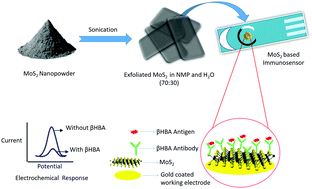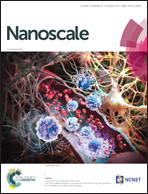Liquid exfoliation of 2D MoS2 nanosheets and their utilization as a label-free electrochemical immunoassay for subclinical ketosis†
Abstract
We report the step-by-step fabrication of a 2D MoS2 nanostructure-based disposable electrochemical immunosensor to detect β-hydroxybutyrate (βHBA), a novel subclinical ketosis biomarker. The MoS2 nanosheets were exfoliated in the liquid phase by ultrasonication, and then followed by deposition on gold colloid modified screen-printed electrodes (Au-SPE). The MoS2-modified electrodes were thoroughly characterized by physical, electrochemical as well as spectroscopic techniques, and the obtained results indicate the successful and irreversible electrodeposition of MoS2 nanosheets. These MoS2-modified disposable electrodes were subsequently bioconjugated with anti-βHBA antibodies and then employed for the label-free immunosensing of the βHBA biomarker to detect subclinical ketosis. A simple electrochemical Differential Pulse Voltammetry (DPV) technique based immunodetection was realized for the sensing of varying concentrations of βHBA antigen. The bioassay demonstrated remarkable sensitivity and specificity having a dynamic linear response range of 0.7 mM to 10 mM for βHBA in standard antigen solutions, spiked serum, blood, milk and clinical samples, with linear results being obtained with R2 ∼ 0.9923. The sensor electrodes were also studied with other relative interferents to investigate cross reactivity and non-specificity. These electrodes showed a linear, specific, reproducible and stable response towards the βHBA antigen over a wide range of concentrations.



 Please wait while we load your content...
Please wait while we load your content...